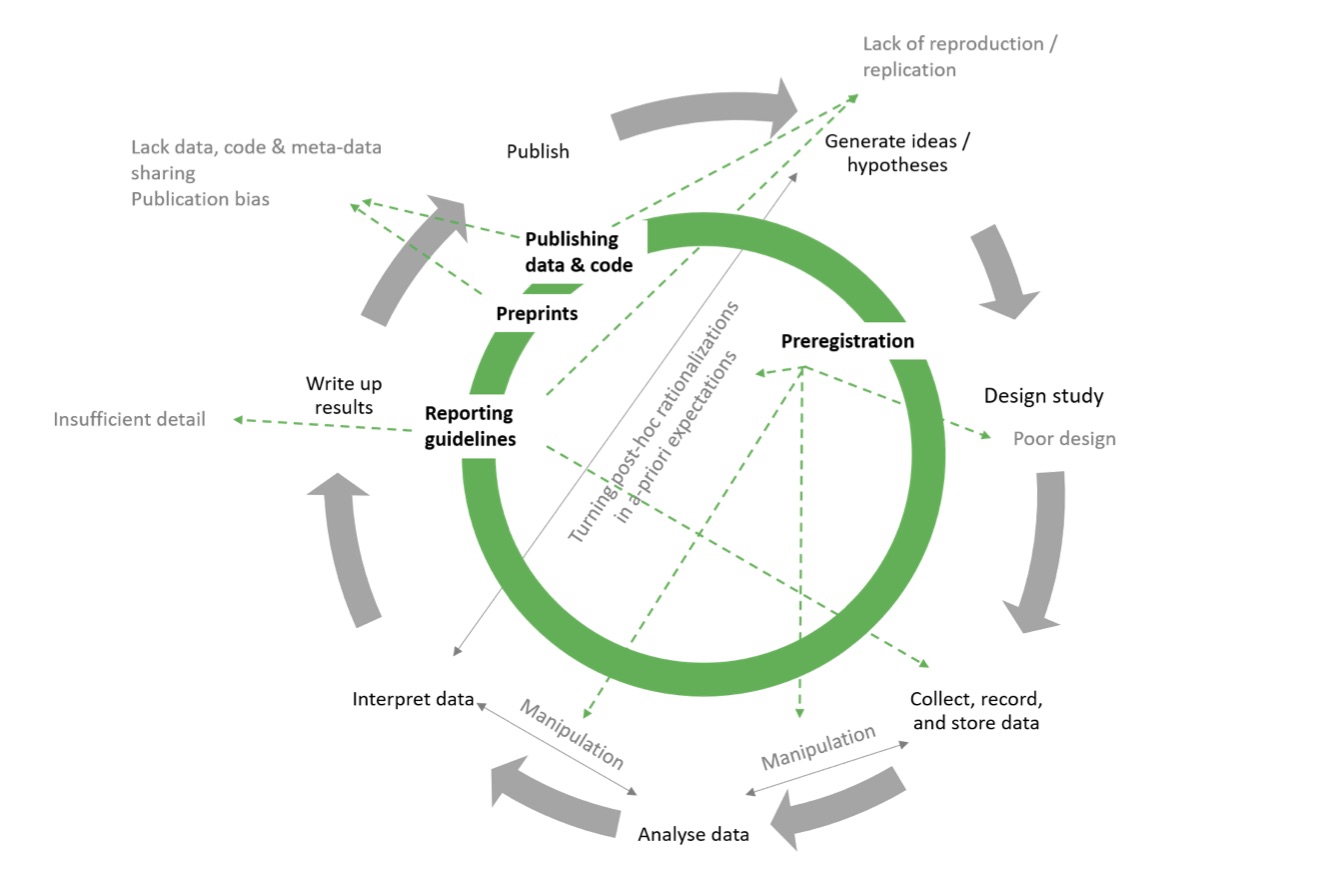
www.buildingsandcities.org/insights/news/quality-energy-research-practices.html
Improving Energy Research Practices
How can energy
research practices be improved? A new approach emphasizing transparency, reproducibility
and quality in a recently published Buildings & Cities peer-reviewed article explains what energy researchers can do to improve their research design, execution and
writing.
A recent peer-reviewed Methods paper, published in Buildings & Cities, explores how practices could be improved in the conduct and publishing of energy research. Huebner, Fell & Watson (2021) highlight the importance of good quality research for applied energy studies, which often inform policy and can be of direct relevance in determining appropriate action for tackling and adapting to climate change. Given the urgency and gravity of this task, they argue that the rigour and quality of energy research should be subject to publishing practices similar to those used in the psychological and medical sciences. This is crucial reading for researchers beginning their careers, those already established, but also research councils and funders. In particular, these readers can gain insight into how to conduct and assess high quality research, and identify resources to support with the planning and implementation of a range of research approaches.
The authors focus on three dimensions of
'good research': transparency, reproducibility and quality and provide a clear
process for thinking about how to implement this into research practices. In
the paper, transparency is taken to mean making the essential components of
research (for example, sampling and analytical approaches) visible to others.
Reproducibility considers how information can be provided such that independent
studies can seek to reproduce results. The authors' preferred definition of
quality is less clear, but the implication is that this includes research which
'poses important questions, uses appropriate methods, assesses bias, and
considers alternative explanations for findings' (p. 3; following a definition
from the National Center for Dissemination of Disability).
Drawing on ideas and practices adapted from other scientific fields, particularly medicine and psychology, four specific tools are introduced for achieving transparency, reproducibility and quality:
- preregistration of analysis plans (pre-analysis plans)
- making data and code publicly available
- using preprints
- employing reporting guidelines
Pre-analysis plans specify the study aims, types of data collection, and data analysis approach. The authors highlight the value of these for preventing the manipulation of research data to present favourable results. Reporting guidelines provide a means to support authors in determining what information to include in papers, for example sampling methods and recruitment processes. The authors suggest that preprints can be helpful for overcoming publishing bias (for example, where journals give preference to studies which demonstrate significant findings). Finally, the authors advocate for open data, or placing available data in an online repository. They highlight research which finds that research using open source data and code receives more citations than those publishing from closed data. A useful mantra, highlighted in the paper, is the European Commission's (2016) principle that research data should be 'as open as possible, as closed as necessary'.
The authors acknowledge that these different tools have varied degrees
of relevance for distinct approaches. For example, exploratory research (where
a strategy for analysis is not pre-determined) may be less amenable to a
pre-analysis plan. However, with hyperlinks to pre-analysis plans and reporting
guidelines for a variety of research approaches (including both qualitative and
quantitative strategies), the article is itself a useful repository to work
from when planning and publishing research. In addition, adopting these
approaches will help to align energy research with accepted best practice in
fields with rigorous checks on research quality, such as medicine.

Source: Huebner, Fell & Watson (2021)
The authors emphasise the need for 'more structural adjustments to the energy research ecosystem' (p.14). In particular, they highlight that some poor research and publishing practices are reinforced by the expectations of journals, for example prioritising the publication of research with significant results or confirming hypotheses, rather than research with 'negative' results.
Diverging from this norm, Buildings
& Cities welcomes Methods articles (like that discussed here) which
outline new techniques and critique existing approaches, and Replication
articles which explicitly set out to test previous findings, validate existing
data, and report results demonstrating 'failure'. With this Methods article,
Huebner, Fell & Watson have opened up dialogue around research quality, and
how tools used in the publishing process can create reassurances around this.
The next task is to work out how to continue this debate such that the broad
gamut of energy researchers can coalesce around a mutually agreed set of
guidance.
Latest Peer-Reviewed Journal Content
Acceptability of sufficiency consumption policies by Finnish households
E Nuorivaara & S Ahvenharju
Key factors for revitalising heritage buildings through adaptive reuse
É Savoie, J P Sapinski & A-M Laroche
Cooler streets for a cycleable city: assessing policy alignment
C Tang & J Bush
Understanding the embodied carbon credentials of modern methods of construction
R O'Hegarty, A McCarthy, J O'Hagan, T Thanapornpakornsin, S Raffoul & O Kinnane
The changing typology of urban apartment buildings in Aurinkolahti
S Meriläinen & A Tervo
Embodied climate impacts in urban development: a neighbourhood case study
S Sjökvist, N Francart, M Balouktsi & H Birgisdottir
Environmental effects of urban wind energy harvesting: a review
I Tsionas, M laguno-Munitxa & A Stephan
Office environment and employee differences by company health management certification
S Arata, M Sugiuchi, T Ikaga, Y Shiraishi, T Hayashi, S Ando & S Kawakubo
Spatiotemporal evaluation of embodied carbon in urban residential development
I Talvitie, A Amiri & S Junnila
Energy sufficiency in buildings and cities: current research, future directions [editorial]
M Sahakian, T Fawcett & S Darby
Sufficiency, consumption patterns and limits: a survey of French households
J Bouillet & C Grandclément
Health inequalities and indoor environments: research challenges and priorities [editorial]
M Ucci & A Mavrogianni
Operationalising energy sufficiency for low-carbon built environments in urbanising India
A B Lall & G Sethi
Promoting practices of sufficiency: reprogramming resource-intensive material arrangements
T H Christensen, L K Aagaard, A K Juvik, C Samson & K Gram-Hanssen
Culture change in the UK construction industry: an anthropological perspective
I Tellam
Are people willing to share living space? Household preferences in Finland
E Ruokamo, E Kylkilahti, M Lettenmeier & A Toppinen
Towards urban LCA: examining densification alternatives for a residential neighbourhood
M Moisio, E Salmio, T Kaasalainen, S Huuhka, A Räsänen, J Lahdensivu, M Leppänen & P Kuula
A population-level framework to estimate unequal exposure to indoor heat and air pollution
R Cole, C H Simpson, L Ferguson, P Symonds, J Taylor, C Heaviside, P Murage, H L Macintyre, S Hajat, A Mavrogianni & M Davies
Finnish glazed balconies: residents' experience, wellbeing and use
L Jegard, R Castaño-Rosa, S Kilpeläinen & S Pelsmakers
Modelling Nigerian residential dwellings: bottom-up approach and scenario analysis
C C Nwagwu, S Akin & E G Hertwich
Mapping municipal land policies: applications of flexible zoning for densification
V Götze, J-D Gerber & M Jehling
Energy sufficiency and recognition justice: a study of household consumption
A Guilbert
Linking housing, socio-demographic, environmental and mental health data at scale
P Symonds, C H Simpson, G Petrou, L Ferguson, A Mavrogianni & M Davies
Measuring health inequities due to housing characteristics
K Govertsen & M Kane
Provide or prevent? Exploring sufficiency imaginaries within Danish systems of provision
L K Aagaard & T H Christensen
Imagining sufficiency through collective changes as satisfiers
O Moynat & M Sahakian
US urban land-use reform: a strategy for energy sufficiency
Z M Subin, J Lombardi, R Muralidharan, J Korn, J Malik, T Pullen, M Wei & T Hong
Mapping supply chains for energy retrofit
F Wade & Y Han
Operationalising building-related energy sufficiency measures in SMEs
I Fouiteh, J D Cabrera Santelices, A Susini & M K Patel
Promoting neighbourhood sharing: infrastructures of convenience and community
A Huber, H Heinrichs & M Jaeger-Erben
New insights into thermal comfort sufficiency in dwellings
G van Moeseke, D de Grave, A Anciaux, J Sobczak & G Wallenborn
'Rightsize': a housing design game for spatial and energy sufficiency
P Graham, P Nourian, E Warwick & M Gath-Morad
Implementing housing policies for a sufficient lifestyle
M Bagheri, L Roth, L Siebke, C Rohde & H-J Linke
The jobs of climate adaptation
T Denham, L Rickards & O Ajulo
Structural barriers to sufficiency: the contribution of research on elites
M Koch, K Emilsson, J Lee & H Johansson
Disrupting the imaginaries of urban action to deliver just adaptation [editorial]
V Castán-Broto, M Olazabal & G Ziervogel
Nature for resilience reconfigured: global- to-local translation of frames in Africa
K Rochell, H Bulkeley & H Runhaar
How hegemonic discourses of sustainability influence urban climate action
V Castán Broto, L Westman & P Huang
Fabric first: is it still the right approach?
N Eyre, T Fawcett, M Topouzi, G Killip, T Oreszczyn, K Jenkinson & J Rosenow
Social value of the built environment [editorial]
F Samuel & K Watson
Understanding demolition [editorial]
S Huuhka
Data politics in the built environment [editorial]
A Karvonen & T Hargreaves



Latest Commentaries
Decolonising Cities: The Role of Street Naming
During colonialisation, street names were drawn from historical and societal contexts of the colonisers. Street nomenclature deployed by colonial administrators has a role in legitimising historical narratives and decentring local languages, cultures and heritage. Buyana Kareem examines street renaming as an important element of decolonisation.
Integrating Nature into Cities
Increasing vegetation and green and blue spaces in cities can support both climate change mitigation and adaptation goals, while also enhancing biodiversity and ecological health. Maibritt Pedersen Zari (Auckland University of Technology) explains why nature-based solutions (NbS) must be a vital part of urban planning and design.